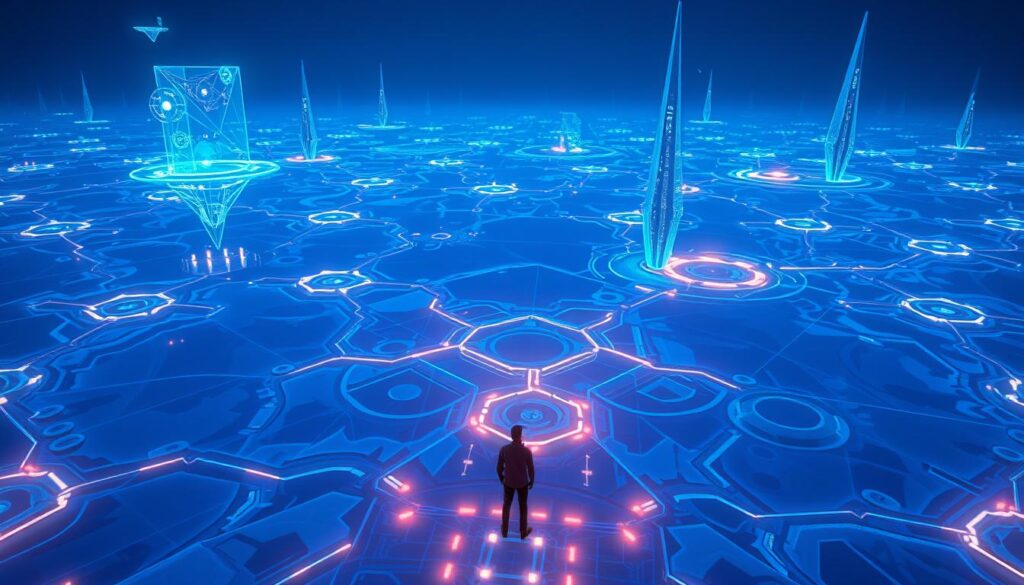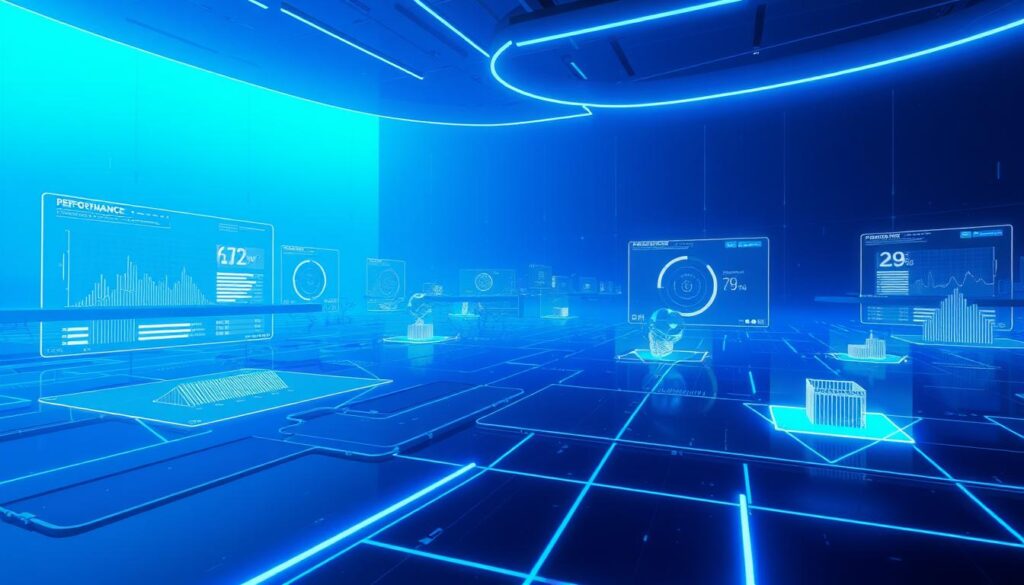Every 30 seconds, a new AI world is born on servers worldwide. This creates over 2,880 unique virtual places every day. This rapid growth is a big step in digital progress.
The race to create immersive virtual worlds reached its peak in August 2025. DeepMind introduced Genie 3 just before August 12. It could generate worlds in real-time, exciting the tech world. But, keeping it closed-source left many wanting more.
Skywork jumped into the gap during their AI Technology Week. On August 12, 2025, they launched Matrix-Game 2.0. It was an open-source answer to DeepMind’s Genie 3.0. This move was a direct response to DeepMind’s announcement.
Now, we’re moving from just watching content to creating our own worlds. Real-time rendering and AI work together. This lets users make their own virtual experiences right away.
Key Takeaways
- DeepMind’s Genie 3 and Skywork’s Matrix-Game 2.0 launched within days of each other in August 2025
- Matrix-Game 2.0 offers the first fully open-source alternative to proprietary world-building platforms
- Real-time AI generation creates 2,880 new virtual environments daily across global platforms
- The shift from passive viewing to active participation transforms user engagement with digital content
- Meta reality simulation technologies now enable instant world creation without coding expertise
The Dawn of Interactive AI World Generation

We are at a key moment. Artificial intelligence is now creating dynamic, interactive worlds. Platforms like Matrix Game 2.0 are changing how we see AI-generated environments. They move us into truly interactive realms.
From Passive Viewing to Active Participation
Before, we just watched AI content or saw static images. Now, with advanced digital environments, we can shape our experience. Matrix Game 2.0 lets us navigate AI-generated 3D worlds with simple controls.
This change is more than just tech progress. It changes how we interact with AI content. We’re no longer just watching; we’re exploring and creating in virtual spaces.
Real-Time Rendering Meets Artificial Intelligence
Combining real-time rendering with AI opens new doors. Systems now respond instantly to user input. This creates consistent visuals across long sequences. It all happens thanks to advanced pipelines, like those in Unreal Engine and Grand Theft Auto.
The Convergence of Technologies
Today’s multiverse technology brings together many technologies:
- Advanced data generation systems capturing detailed gameplay scenarios
- Real-time processing engines maintaining visual coherence
- Intuitive control systems aligning user actions with scene dynamics
- AI models capable of understanding spatial relationships and physics
This mix makes experiences that were once science fiction a reality. Users can now explore vast, AI-generated worlds that react to their actions.
DeepMind’s Genie 3: Breaking New Ground

DeepMind has changed the AI world with Genie 3.0. This system offers an immersive digital experience like no other. It’s a big step forward in making interactive worlds with AI.
Genie 3.0 came out in early August 2025. It shows DeepMind’s skill in creating long sequences. It makes worlds that change with what you do, keeping things consistent over time. This has caught the eye of many around the world.
Genie 3.0 is special because it makes worlds that feel real and interactive. People say it’s like playing in a world that really responds to you. This makes the experience feel very real.
DeepMind’s choice to keep Genie 3.0 to themselves has started a big debate. Many wanted it to be open-source. But DeepMind wants to keep it to themselves. This has made many curious about how it works.
Genie 3.0 is more than just a technical achievement. It’s a big change in how we see AI-made content. It shows AI can make worlds that are not just interesting but also interactive and engaging.
Genie 3.0 Matrix World 2.0 Meta: Performance Benchmarks

These platforms set new standards for creating interactive worlds. They show amazing abilities that expand what’s possible in virtual environments. These achievements mark a big step forward for next-generation virtual world tech, overcoming old limits that stopped it from being widely used.
Ultra-Low Latency Achievement
Matrix Game 2.0 has response times under 50 milliseconds. This makes the experience feel instant to users. It matches Google VR‘s standards, ensuring smooth interactions without noticeable delays.
25 FPS Continuous Video Generation
Stable frame rates are key for an immersive experience. The platform keeps a steady 25 frames per second, even with complex scenes. This ensures smooth motion and natural character movements during long play sessions.
Minute-Long Sequence Capabilities
The system can create sequences over five minutes long. Each minute-long segment stays consistent, with characters and objects acting as they should. This ability opens up new chances for storytelling and gameplay in next-generation virtual world environments, rivaling traditional game engines with more creative freedom.
Matrix Game 2.0: The Open-Source Revolution
The world of interactive world generation changed with Skywork’s release of Matrix Game 2.0. This move made the platform open-source. It changed how developers and creators use advanced world-building tech, making it more open to the community in the ai virtual universe.
First Fully Open-Sourced Interactive World Model
Matrix Game 2.0 is a big step forward in open-source tech for interactive worlds. It lets developers worldwide make immersive experiences without needing a license. The tech works well with meta vr platforms and keeps high performance standards.
Skywork’s AI Technology Week Unveiling
Skywork made a big splash during their AI Technology Week in August 2025. They released new models every day from 11-15 August. The big reveal of Matrix Game 2.0 on 12 August was a game-changer for world-building tools.
Democratising Advanced World Building
The release package changed how creators make virtual worlds:
- Technical guides on GitHub
- Full source code on Skywork’s HuggingFace platform
- Demos on the project’s homepage
- Forums for community help
This change lets small teams make complex worlds like big studios. It brings new ideas to the meta vr world, making it more diverse and exciting.
Core Technological Innovations Behind Matrix Game 2.0
Matrix Game 2.0 leads in meta reality simulation with three key technologies. These innovations tackle long-standing challenges for developers.
The first innovation is a massive video dataset. It has about 1,200 hours of high-quality content. This dataset captures real-world movements, making the game worlds feel alive.
The second innovation is action-conditional control modules. These systems allow for detailed control over game events. Players use keyboard and mouse to control their actions, with the AI reacting quickly.
The third innovation is a focus on gameplay architecture. Matrix Game 2.0 is trained in three environments:
- Matrix-Game Uni for photorealistic exploration
- Matrix-Game TempleRun for precise response control
- Matrix-Game GTA for dynamic vehicle simulation
“We’ve solved the synchronisation puzzle between camera signals, keyboard inputs, and authentic game mechanics that has limited interactive AI for decades.”
These technologies work together for smooth meta reality simulation. The system handles WASD and arrow key inputs perfectly. It ensures the game world reacts naturally to player commands.
Three Defining Advantages of Next-Generation World Models
The latest AI breakthroughs in world generation are huge steps forward. They create immersive digital experiences like never before. These systems show off realism and adaptability, making virtual worlds more real than ever.
Multi-Scene Generalisation
Modern multiverse technology can adapt to many different environments. Unlike old systems, these new models can handle everything from busy cities to peaceful nature spots. They keep quality high, no matter the change.
Physics Consistency in Complex Environments
Believable virtual worlds need more than just looks. The latest systems keep logical physics consistent in complex places. Characters move and act naturally, making the experience feel real.
Cross-Domain Adaptability
The biggest leap is switching between visual styles and genres easily. These systems support:
- Photorealistic rendering for lifelike simulations
- Artistic styles including oil painting aesthetics
- Various architectural and environmental themes
- Seamless transitions between different visual paradigms
This flexibility lets creators explore many artistic visions. It opens up new possibilities for developers.
Industrial-Scale Data Architecture
Creating a next-generation virtual world needs lots of different, high-quality data. The latest systems handle about 1,200 hours of real-world actions and scenarios. This big effort sets new standards for AI world-building.
Modern data generation uses strong engines like Unreal Engine and Grand Theft Auto. These engines gather detailed gameplay info, from character actions to how they interact with the environment. The setup allows for:
- Dynamic camera perspectives and angles
- Variable vehicle and pedestrian density
- Realistic weather effects and atmospheric conditions
- Time-of-day lighting variations
This detailed data collection helps Genie 3.0 and others create stable, ongoing video sequences in various scenarios. The wide range of data lets models handle busy cities to calm nature scenes.
The advanced setup captures small physics details and motion patterns missed by old datasets. Each hour of data has millions of frames, object paths, and environmental changes. This depth is key to making virtual worlds seem real.
By combining big data collection with advanced processing, these systems achieve amazing realism. They create a strong platform for making consistent, physics-accurate virtual spaces that act naturally with user input.
Advanced Control Systems and User Interaction
Interactive world generation has evolved, bringing us advanced control systems. These systems are as good as those in traditional games. Now, AI-powered environments have user-friendly interfaces. They make interacting with virtual spaces feel as real as in google vr and meta vr.
Action-Conditional Control Modules
These modules let us control virtual worlds with precision. Every action we take causes the world to react instantly. This creates smooth, immersive experiences that change based on what we do.
Frame-Level Keyboard and Mouse Inputs
WASD controls have been updated for AI worlds. Users can move around in:
- Forward and backward movement with W/S keys
- Lateral navigation using A/D commands
- Camera rotation through arrow keys
- Mouse-driven view adjustments
This system processes inputs frame by frame. It ensures zero input lag, matching meta vr’s speed and beating many games.
Gameplay-Centric Architecture Design
There are three main models of this architecture. Matrix-Game Uni offers realistic exploration. Matrix-Game TempleRun is great for fast-paced games. Matrix-Game GTA is perfect for complex vehicle simulations.
Each model is designed for different types of interaction. They rival google vr experiences while being consistent across various game styles.
Enterprise Applications and Industry Impact
The move from old content making to ai virtual universe creation is a big change for businesses. Matrix Game 2.0 brings real benefits that help companies make more money. It also opens up new ways for businesses to earn.
Teams can make things much faster with this new tech. What took months before can now be done in days or weeks. Matrix Game 2.0 makes videos smoothly at 25 frames per second. This lets companies quickly try out new ideas without losing quality.
This change is not just about saving money. It lets companies do things they couldn’t before, even with big budgets. The main benefits are:
- Less need for big equipment to make complex scenes
- No more waiting for production to catch up
- Being able to make more of what people want
- New types of products in interactive fun
How businesses make content is changing. Marketing teams create deep brand experiences in meta reality simulation worlds. Game makers can test out whole worlds before spending a lot. Film studios can plan out complex scenes with more control.
This tech makes it easier for small studios to compete with big ones. It turns creative ideas into real, profitable things in entertainment, education, and training.
Technical Foundations: VAE and Diffusion Transformers
Matrix-Game 2.0’s architecture is a major leap in creating immersive digital worlds. It uses advanced machine learning to generate worlds in real-time. This makes it possible to explore new levels in interactive media.
3D Causal Variational Autoencoder
The 3D Causal VAE is key to this multiverse technology. It packs a lot of data into smaller forms. This lets the system handle complex scenes without losing detail.
The causal part makes sure things happen in a logical order. This stops the world from feeling unrealistic or broken.
Multimodal Diffusion Transformer Integration
Adding diffusion transformers is a big step forward. It lets the system understand and act on user inputs better. This makes the world feel alive and interactive.
It combines visual and command inputs to create natural sequences. This way, the world changes in real-time based on what the player does.
Self-Forcing Training Strategy
The self-forcing method is a new way to train generative models. It uses a mix of autoregressive diffusion and targeted training. This reduces delays that slow down real-time applications.
It makes sure the advanced digital environment responds well to user actions. Even with complex scenes, the system performs smoothly.
Future Horizons: Metaverse, Gaming, and Beyond
The mix of AI and world-building opens new doors for creative fields. With Matrix Game 2.0’s quick responses, we’re seeing the start of a new era in making content. The idea of a next-generation virtual world is becoming a reality, changing how we enjoy, learn, and connect.
Virtual Humans and Embodied AI
Embodied AI is the next step in making digital characters seem real. These virtual beings will fill our digital worlds, reacting to us in a natural way. Firms like Soul Machines and UneeQ are leading in making avatars that feel and act like real people.
Matrix Game 2.0 lets these characters live in worlds that change with them. They can be virtual helpers, teachers, or friends, adapting to their surroundings as they go.
Next-Generation Game Engines
Game engines like Unreal Engine 5 and Unity are getting smarter with AI. This means:
- Environments that change with what the player does
- Stories that grow and change with what everyone plays
- Graphics that look real and happen in real-time
Epic Games’ investment in AI shows how big this change is. Soon, our digital worlds will feel just like real life.
Large-Scale Film and Entertainment Production
Film studios are using AI to save money and explore new ideas. Virtual production stages, like Disney’s “The Mandalorian,” are becoming more interactive. Directors can change scenes quickly, trying out different versions in the same virtual world.
“The future of filmmaking lies in the seamless blend of physical and digital realms, where creativity knows no bounds.” – Jon Favreau, Director
Conclusion
The world of AI world building has hit a major milestone. Genie 3.0 and Matrix Game 2.0 show two ways to make interactive, AI-created worlds. DeepMind’s system is at the forefront, while Skywork’s is open to all developers.
This race is more than just a competition. Google VR and Meta VR are keeping a close eye. They see the chance to change how we use virtual spaces. The ability to create realistic environments fast is opening new doors.
These advancements will shape our future. The open-source Matrix Game 2.0 means everyone can use advanced world generation. This could speed up the development of artificial general intelligence. It will change industries like gaming and film.
Genie 3.0 and Matrix Game 2.0 are starting a new era. They will change how we build and enjoy virtual worlds. This is just the beginning of something big.
Want to hire me as a Consultant? Head to Channel as a Service and book a meeting.

